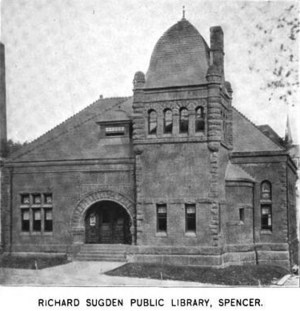Spencer, Massachusetts facts for kids
Quick facts for kids
Spencer, Massachusetts
|
||
|---|---|---|

Spencer's Memorial Town Hall, on Main Street at Maple Street.
|
||
|
||
| Motto(s):
Look to the Future
|
||

Location in Worcester County and the state of Massachusetts.
|
||
| Country | United States | |
| State | Massachusetts | |
| County | Worcester | |
| Settled | 1721 | |
| Incorporated | 1753 | |
| Government | ||
| • Type | Open town meeting | |
| Area | ||
| • Total | 34.1 sq mi (88.2 km2) | |
| • Land | 32.9 sq mi (85.1 km2) | |
| • Water | 1.2 sq mi (3.1 km2) | |
| Elevation | 925 ft (282 m) | |
| Population
(2020)
|
||
| • Total | 11,992 | |
| • Density | 351.7/sq mi (135.96/km2) | |
| Time zone | UTC−5 (Eastern) | |
| • Summer (DST) | UTC−4 (Eastern) | |
| ZIP Code |
01562
|
|
| Area code(s) | 508 / 774 | |
| FIPS code | 25-66105 | |
| GNIS feature ID | 0618385 | |
| Website | www.spencerma.gov | |
Spencer is a town located in Worcester County, Massachusetts, in the United States. In 2020, about 11,992 people lived there.
Spencer is known for its history and its beautiful natural areas. It's a place where you can learn about old inventions and enjoy the outdoors.
Contents
History of Spencer
Spencer was first settled in 1717 by Nathaniel Wood. The first person to live there permanently was Samuel Bemis in 1721.
The town is in central Worcester County. It's about 20 minutes west of Worcester. Spencer officially became a town on April 12, 1753. It separated from the town of Leicester. The town was named after Spencer Phips, who was the acting governor of Massachusetts at that time.
Early Travel and Famous Visitors
In 1784, Spencer was an important stop on the Old Boston Post Road. This was a main route for stagecoaches traveling between Boston and Hartford, and then on to New York. Travelers would often switch stagecoaches in Spencer. Many people, including famous figures like General Henry Knox and George Washington, stayed overnight at Jenk's Tavern in Spencer. You can still see old milestone markers in Spencer that show where the old post road was.
Spencer in Wars
When the War of Independence started in 1775, Spencer was ready to help. Fifty-six men from Spencer quickly went to Boston. Many of them fought in the Battle of Bunker Hill. Later, during the Civil War, 313 men from Spencer served. Thirty-two of them died while serving their country.
Industry and Inventions
Spencer's first mill was built in 1740 on the Seven Mile River. This river was a great source of waterpower for the town. Over time, Spencer became known for making shoes and drawing wire. Josiah Green started making shoes in 1811. The Prouty family also began making shoes in 1820. Elliot Prouty started a wire-drawing business in 1812. At one point, Spencer had 11 factories and 26 buildings for making wire.
Spencer is also famous for its inventors, the Howe family. William Howe invented a special wooden bridge design. His brother, Tyler Howe, created the spring bed. Their nephew, Elias Howe, Jr., became very famous for inventing the lockstitch sewing machine.
Public Buildings and Institutions
The town hall was built in 1839. Later, Denny Hall became the town's first high school. In the late 1800s, four important citizens gave the town a new high school, a library, a public park, and fairgrounds.
Spencer is home to Saint Joseph's Abbey. This is a special monastery where Trappist monks live. They support themselves by making liturgical garments (church clothes), jams and jellies called Trappist Preserves, and for a time, Spencer Trappist Ale. They stopped making beer in 2022.
Recent Events
In 2007, there was a problem at one of the town's water treatment places. Too much of a chemical called lye was accidentally released into the water. This caused some people to have skin irritation.
In 2023, the First Congregational Church in Spencer was destroyed by a fire. The fire started after a lightning strike.
Geography of Spencer
Spencer covers about 34 square miles (88 square kilometers). Most of this area is land, with about 1.2 square miles (3.1 square kilometers) being water.
The town is shaped like a rectangle. It shares borders with several other towns. To the east is Leicester, and to the south is Charlton. To the west are East Brookfield and North Brookfield. To the northwest is New Braintree, to the north is Oakham, and to the northeast is Paxton.
Two main state highways, Route 31 (north-south) and Route 9 (east-west), divide the town into quarters. Another highway, Route 49, connects the western parts of Spencer to nearby Sturbridge.
Spencer has many parks and hiking trails. These include the Burncoat Pond Wildlife Sanctuary, which is protected by the Massachusetts Audubon Society. There's also Spencer State Forest/Howe State Park, which is where inventor Elias Howe was born.
Population and People
Spencer has grown steadily over the years. In 1850, about 2,244 people lived there. By 2020, the population had grown to 11,992.
Most of the people living in Spencer are White. There are also smaller groups of African American, Native American, and Asian residents. About 1.33% of the population identifies as Hispanic or Latino.
The town has a mix of families and individuals. About 31.7% of households have children under 18. The average household has about 2.53 people. The median age in Spencer is 37 years old.
Arts and Culture in Spencer
Spencer Public Library
The Spencer public library first opened in 1870. The town supports its library, spending money each year to keep it running for everyone. In 2017, the town spent about $31.95 per person on the library.
Education in Spencer
Spencer's public schools are shared with East Brookfield. This means students from both towns attend some of the same schools.
- Students in kindergarten through fourth grade go to Wire Village School.
- Students in grades 5-8 attend Knox Trail Junior High School. However, only Spencer students attend 6th grade there.
- For high school, students in grades 9-12 go to David Prouty High School.
Some students also have the option to attend Bay Path RVTHS for high school after 8th grade.
In 2015, over 200 students at David Prouty High School held a sit-in. They were protesting issues like a lack of new textbooks and cuts to music, theater, and band programs. They wanted their voices to be heard by the school administration.
Notable People from Spencer
Many interesting people have come from Spencer, including:
- Donnie Berthiaume, a member of the Massachusetts House of Representatives.
- Don Brown, a college football coach.
- Nathan Cobb, known as "the father of nematology" (the study of tiny worms).
- Peter Durant, a member of the Massachusetts House of Representatives.
- Anne Gobi, a member of the Massachusetts Senate.
- Elias Howe, inventor of the sewing machine.
- Tyler Howe, inventor of the box-spring bed.
- William Howe, an architect.
- Phineas Jones, a member of the United States House of Representatives.
- Patrick Ricard, a player in the National Football League.
- Rufus Sibley, who founded the Sibley's department store.
- Leah Van Dale, a professional wrestler known as Carmella in WWE.
Images for kids
See also
 In Spanish: Spencer (Massachusetts) para niños
In Spanish: Spencer (Massachusetts) para niños






